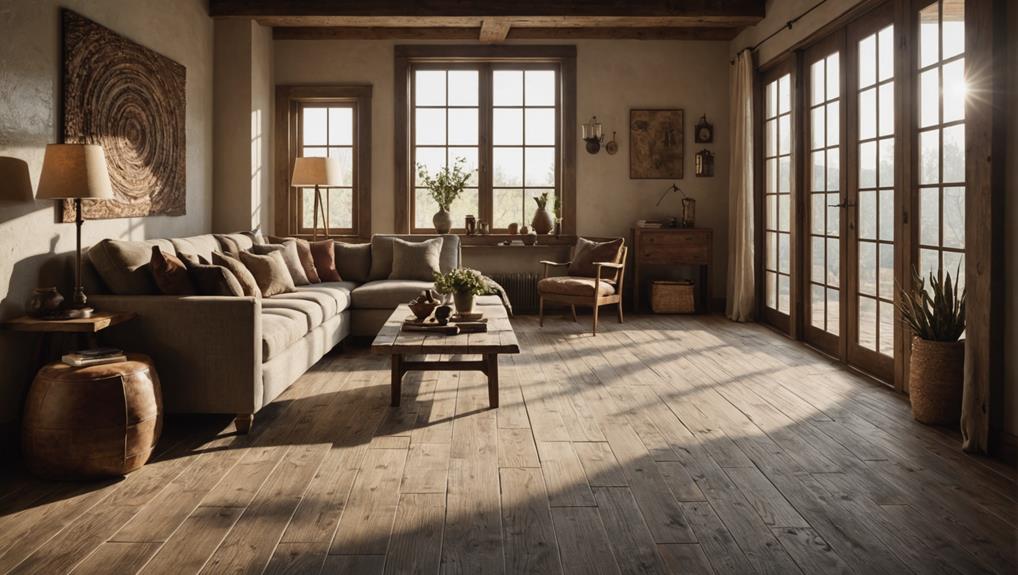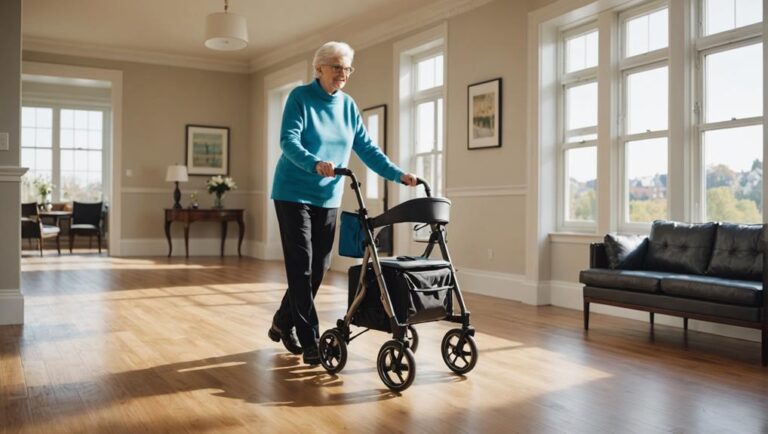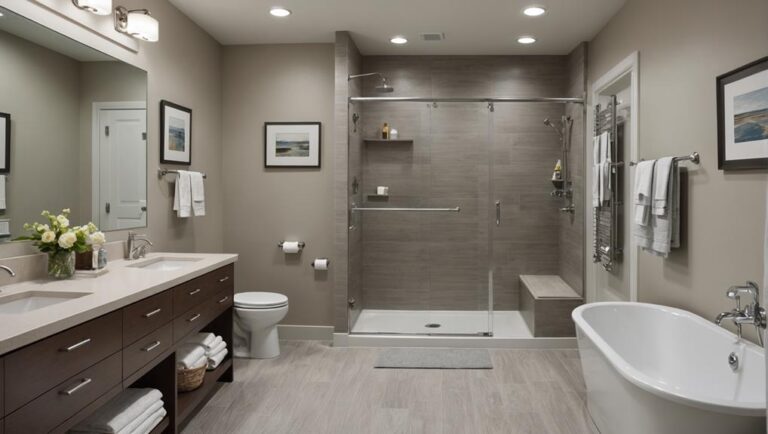Choosing textured floors means prioritizing both safety and style. These surfaces enhance your home's aesthetic while providing superior traction, reducing slip risks in high-traffic areas. Options like textured vinyl or rubber not only add depth to your space but also hide dirt and imperfections, making maintenance a breeze. Think about where you'll use them—kitchens, living rooms, or play areas all benefit from textures that absorb impact and sound. Plus, the right material can elevate comfort underfoot. If you explore your choices further, you'll find how to seamlessly blend function with flair in your 床材 decisions.
Importance of Textured Flooring
When you step into a space with textured flooring, it instantly brings a unique vibe that can elevate the entire atmosphere. The tactile quality of textured surfaces not only catches the eye but also serves a practical purpose. One of the key benefits of textured flooring is its ability to provide better traction, reducing the risk of slips and falls, especially in high-traffic areas or homes with young children and elderly residents. The careful texture analysis of various materials shows that certain designs can greatly enhance safety while maintaining aesthetic appeal.
As flooring trends evolve, more homeowners and designers are opting for textured options that blend style with functionality. From subtle grooves to bold patterns, these designs can transform a mundane room into a chic sanctuary. Imagine walking on a beautifully finished wood floor with a slight texture, offering a warmth that smooth surfaces simply can't match. It draws you in, making you want to linger.
Moreover, textured flooring can also hide dirt and imperfections better than flat surfaces, making it easier to maintain a clean environment. This practical aspect aligns with a growing desire for both beauty and functionality in home design. By choosing textured flooring, you're not just making a style statement; you're prioritizing safety and comfort for everyone who enters your space. So, as you explore your options, consider how texture can enhance your home's atmosphere while keeping it safe and inviting.
Types of Textured Flooring
Textured flooring comes in a variety of styles, each offering its unique charm and function. When you're looking for flooring that not only enhances the aesthetics of your space but also provides safety, understanding the types of textured materials available is vital. Here are a few popular options:
| Type of Textured Flooring | 説明 | Ideal Use |
|---|---|---|
| Vinyl Textured Planks | Durable, water-resistant, and comes in various designs. | Kitchens and bathrooms |
| Textured Carpet | Soft underfoot, designed with patterns that resist slipping. | Living rooms and bedrooms |
| Textured Laminate | Mimics wood grain with added surface texture for grip. | Entryways and hallways |
| ゴム製床材 | Provides excellent traction, often used in commercial spaces. | Gyms and play areas |
| コルクフローリング | Natural texture offering cushioning and sound absorption. | Home offices and kids' rooms |
Each of these textured flooring options not only contributes to your home's flooring aesthetics but also plays a significant role in enhancing safety. The varied surfaces can reduce the likelihood of slips and falls, making them practical choices for any room. By selecting the right type of textured flooring, you can create a beautiful environment while prioritizing safety and functionality. So, consider your needs and preferences while exploring these textured materials, ensuring you find the perfect match for your space.
Benefits of Textured Surfaces
With a blend of aesthetic appeal and practical functionality, textured surfaces offer numerous benefits that can transform your living spaces. One of the most significant advantages is the enhanced surface traction they provide. Whether you're walking barefoot or in socks, textured floors reduce the risk of slipping, making them an excellent choice for homes with children or elderly family members.
Imagine stepping onto a beautifully textured floor that not only catches the eye but also gives you peace of mind. The texture benefits extend beyond safety; they contribute to the overall design of your space. Textured surfaces can add depth and character, allowing you to create a warm, inviting atmosphere. From rustic wood to stylish stone, there's a variety of options that can complement your decor while ensuring safety.
Moreover, these surfaces can help hide dirt and imperfections, making maintenance a breeze. Unlike smooth flooring, which may show every scuff or smudge, textured options can mask minor flaws, keeping your home looking pristine with less effort.
In addition to practicality and aesthetics, textured surfaces can also improve acoustics within your home. The irregularities in the floor can help absorb sound, resulting in a quieter, more serene environment.
Ultimately, choosing textured flooring is about more than just looks; it's about creating a safe, beautiful, and functional home. Embrace the texture benefits and enjoy the reassurance that comes with improved surface traction.
Choosing the Right Material
Amid the myriad of options available, selecting the right material for your textured floors is crucial in achieving both style and functionality. You want a surface that not only looks great but also provides safety underfoot. The right choice can enhance your space while guaranteeing durability and minimal environmental impact. Here are three key factors to evaluate:
- 素材の耐久性: Look for materials that can withstand daily wear and tear. Tiles, for instance, offer excellent longevity and resistance to scratches, making them a smart choice for high-traffic areas. Hardwood, while beautiful, may require more maintenance but can also last for decades with proper care.
- Slip Resistance: Safety should be your top priority. Textured surfaces like vinyl or rubber flooring are designed to provide better grip, especially in moisture-prone areas such as kitchens or bathrooms. Confirm the material you choose has a high coefficient of friction to reduce the risk of slips and falls.
- 環境への影響: Reflect on how your choice affects the planet. Opt for materials that are sustainably sourced or made from recycled content. Bamboo and cork are both eco-friendly options that boast durability and unique aesthetics, allowing you to make a stylish yet responsible choice.
Textured Flooring for Different Spaces
Choosing the right textured flooring can transform both your home and workspace. In residential living areas, you might seek warmth and comfort, while commercial spaces often demand durability and a polished look. Understanding the unique needs of each space helps you create an inviting atmosphere without sacrificing functionality.
Residential Living Areas
Textured flooring can transform your residential living areas into inviting and stylish spaces. When you choose the right texture, you're not only enhancing the aesthetic appeal but also prioritizing safety and comfort. Here are three essential factors to take into account:
- Slip Resistance: Textured floors offer grip, reducing the chances of accidents, especially in high-traffic areas like hallways and living rooms. This is particularly important for families with children or elderly members.
- Design Trends: Incorporating textured flooring aligns with modern design trends, adding depth and character to your home. Whether you prefer rustic wood grains or contemporary stone patterns, there's a texture that complements your style.
- Comfort Factors: Textured surfaces provide a more comfortable walking experience, absorbing impact and reducing fatigue. This is crucial for areas where you spend a lot of time, like living rooms or family gathering spaces.
Commercial Spaces Considerations
When it comes to commercial spaces, selecting the right flooring can greatly impact both functionality and aesthetics. You want a surface that not only looks appealing but also meets the demands of high foot traffic. Textured flooring is a fantastic choice here, offering both style and safety. With the latest design trends emphasizing natural textures and earthy tones, you can create an inviting atmosphere while ensuring your space remains practical.
Consider the flooring durability as a priority; textured options provide excellent slip resistance, reducing the risk of accidents in busy areas. Whether you're outfitting a restaurant, retail store, or office, think about how different textures can enhance your environment—smooth finishes may not be ideal in areas prone to spills, while more rugged surfaces can withstand heavy wear.
Additionally, textured flooring can contribute to sound absorption, offering a quieter ambiance, which is essential in commercial settings. By choosing wisely, you not only elevate the aesthetic appeal of your space but also create a safer environment for both employees and customers. With the right textured flooring, you're making a smart investment in both style and safety.
Maintenance Tips for Textured Floors
Although maintaining textured floors might seem challenging at first, a few simple practices can keep them looking stunning and prolong their lifespan. By implementing proper cleaning techniques and surface restoration methods, you'll guarantee your floors remain both safe and visually appealing.
Here are three essential maintenance tips for your textured floors:
- 定期的な掃き掃除と掃除機かけ: Start by sweeping or vacuuming your floors at least once a week. This helps remove dirt, debris, and any particles that could scratch the surface over time. Opt for a vacuum with a soft brush attachment to avoid damaging the texture.
- Gentle Cleaning Solutions: When it's time to mop, use a gentle, pH-neutral cleaning solution mixed with warm water. Avoid harsh chemicals, as they can deteriorate the texture and finish of your floors. A microfiber mop is ideal, as it effectively captures dirt without scratching the surface.
- Periodic Surface Restoration: To maintain the integrity of your textured floors, consider scheduling professional surface restoration every couple of years. This process can remove scuffs and stains, revitalizing the appearance of your floors while guaranteeing safety for those who walk on them.
Aesthetic Considerations
Maintaining your textured floors not only keeps them in top shape but also enhances their visual appeal, making them a focal point in your home. When considering aesthetic choices, you'll want to think about how color choices and pattern variations can complement your overall design theme. Textured floors can bring warmth and depth to your space, making it both inviting and stylish.
Here's a simple table to help you visualize some popular options:
| Color Choices | Pattern Variations | Suggested Room |
|---|---|---|
| Warm neutrals | Herringbone | リビングルーム |
| Cool grays | Geometric | 台所 |
| Earthy tones | Organic shapes | 寝室 |
Choosing the right color can set the mood of your space. Warm neutrals create a cozy atmosphere, while cool grays offer a modern, sleek touch. Pattern variations add a dynamic element, drawing the eye and enhancing the floor's texture. For example, a herringbone pattern can lend sophistication, while organic shapes evoke a more relaxed vibe.
In addition, consider how these choices can affect the light in your room. Lighter colors tend to reflect light, making spaces feel larger, while darker tones can create intimacy. By thoughtfully selecting color choices and pattern variations, you can elevate the aesthetics of your textured floors, ensuring they not only provide safety but also contribute to the beauty of your home.
Safety Standards and Regulations
When choosing textured floors, it's vital to understand safety standards and regulations to guarantee a secure environment. You'll want to pay attention to building code compliance and slip resistance guidelines, as these factors can greatly impact both safety and aesthetics. By prioritizing these elements, you can create a beautiful space that also protects those who walk on it.
Building Code Compliance
Maneuvering the intricate landscape of building code compliance is crucial for guaranteeing safety and quality in your choice of textured floors. Understanding these codes not only helps you select the right flooring but also assures that your space meets the required standards during building inspections. Staying informed about regulatory updates can considerably impact your decision-making process.
When considering textured floors, keep these three critical points in mind:
- Material Compliance: Confirm the flooring material adheres to local and national safety standards, providing the required durability and slip resistance.
- Installation Practices: Follow the recommended installation guidelines to maintain structural integrity and prevent hazards. Poor installation can lead to costly renovations and safety risks.
- メンテナンス要件: Regular upkeep is essential. Many codes specify cleaning protocols to prevent slippery conditions, so familiarize yourself with these requirements to guarantee long-term safety.
Slip Resistance Guidelines
Choosing flooring with the right slip resistance is essential for both safety and comfort in any space. To guarantee you're making a wise choice, it's vital to understand slip resistance guidelines set by safety standards and regulations. You'll want to look for surface material analysis, which evaluates how different textures can affect traction under various conditions.
When selecting textured floors, consider slip resistance testing results. These tests measure the floor's ability to prevent slips, especially in high-traffic areas or places prone to moisture, like kitchens and bathrooms. A higher coefficient of friction indicates better slip resistance, giving you peace of mind in your choice.
It's also wise to consult local building codes, as they often mandate specific slip resistance criteria for commercial spaces or public areas. Don't overlook the importance of proper maintenance; even slip-resistant materials can become hazardous when dirty or worn. Regular cleaning helps retain the surface's grip, guaranteeing safety for everyone.
Cost vs. Value Analysis
Steering through the world of textured floors can feel overwhelming, especially when weighing the cost against the value they bring. You want to ascertain your investment not only fits your budget but also enhances safety and aesthetics in your space. A thorough cost analysis and value assessment will guide you in making the right choice.
Here are three critical factors to reflect on:
- Durability vs. Initial Cost: Textured floors may have a higher upfront cost than traditional options, but their durability often results in lower long-term maintenance expenses. Investing in quality can save you money and reduce the likelihood of accidents due to wear and tear.
- Safety Features vs. Aesthetic Appeal: While the primary goal is safety, you shouldn't have to compromise on style. Many textured floorings offer both slip resistance and beautiful designs, making your space both secure and visually appealing. Reflect on how each option aligns with your design preferences.
- Resale Value vs. Personal Use: If you plan to sell your home, high-quality textured flooring can increase your property's resale value. Potential buyers often prioritize safety features, making this choice a smart investment. If you're staying put, think about the comfort and security it brings to you and your family.
よくある質問
Can Textured Flooring Be Installed Over Existing Surfaces?
Yes, textured flooring can often be installed over existing surfaces, but there are important installation considerations to keep in mind. You'll need to guarantee the original surface is clean, smooth, and properly prepared to avoid issues down the line. Inadequate surface preparation can lead to unevenness and potential safety hazards. By taking the time to prepare, you'll not only enhance the aesthetic appeal but also guarantee a safer, more stable environment for everyone.
How Does Textured Flooring Affect Indoor Air Quality?
Have you ever wondered how your flooring choice impacts the air you breathe? Textured flooring can enhance indoor air quality by reducing airborne pollutants and improving moisture control. The surfaces trap dust and allergens, preventing them from circulating in the air, creating a safer environment for you and your loved ones. Plus, its unique design adds character to your space while promoting a healthier atmosphere. Choosing wisely can make a significant difference in your home's safety.
Are There Eco-Friendly Options for Textured Flooring?
Yes, there are eco-friendly options for textured flooring! You can choose sustainable materials like bamboo or cork, which not only provide a unique aesthetic but also contribute to a healthier environment. Natural finishes enhance the beauty of these floors while ensuring safety for you and your family. When selecting your flooring, consider options that promote air quality and reduce harmful chemicals, making your space both stylish and practical.
What Tools Are Needed for Textured Flooring Installation?
Installing textured flooring's like crafting a beautiful mosaic; you'll need the right tools to piece it together safely. Start with a utility knife for trimming, a floor roller for proper adhesion, and a trowel for spreading adhesive. Don't forget measuring tape and a level for precision. As for maintenance tips, keep a soft broom handy and consider a damp mop to preserve that beautiful texture while ensuring safety in your space.
How Does Textured Flooring Impact Home Resale Value?
Textured flooring can greatly impact your home's resale value. It adds a unique aesthetic appeal that many buyers appreciate, enhancing your space's overall charm. Resale trends show that homes with visually striking and practical flooring often attract higher offers. Plus, the added safety of textured surfaces can be a strong selling point, appealing to families and older buyers. Investing in texture aesthetics can make your home stand out in a competitive market.




